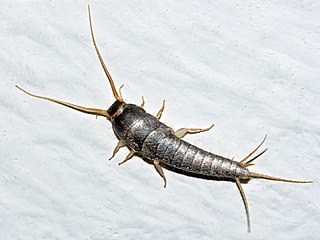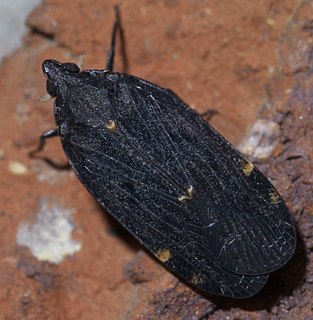
Moths are a paraphyletic group of insects that includes all members of the order Lepidoptera that are not butterflies, with moths making up the vast majority of the order. There are thought to be approximately 160,000 species of moth, many of which have yet to be described. Most species of moth are nocturnal, but there are also crepuscular and diurnal species.

El Yunque National Forest, formerly known as the Caribbean National Forest, is a forest located in northeastern Puerto Rico. It is the only tropical rainforest in the United States National Forest System and the United States Forest Service.

Senna spectabilis is a plant species of the legume family (Fabaceae) in the subfamily Caesalpinioideae native to South and Central America. They are often grown as an ornamental in front yards, parks, gardens, buildings etc. due to their bright yellow flowers that bloom during the summer months. They are also known as golden wonder tree, American cassia, popcorn tree, Cassia excelsa, golden shower tree or Archibald's cassia.

Zoophily is a form of pollination whereby pollen is transferred by animals, usually by invertebrates but in some cases vertebrates, particularly birds and bats, but also by other animals. Zoophilous species frequently have evolved mechanisms to make themselves more appealing to the particular type of pollinator, e.g. brightly colored or scented flowers, nectar, and appealing shapes and patterns. These plant-animal relationships are often mutually beneficial because of the food source provided in exchange for pollination.

Juniperus excelsa, commonly called the Greek juniper, is a juniper found throughout the eastern Mediterranean, from northeastern Greece and southern Bulgaria across Turkey to Syria and Lebanon, Jordan and the Caucasus mountains.

Rosewood refers to any of a number of richly hued timbers, often brownish with darker veining, but found in many different hues.

Rhapis excelsa, also known as broadleaf lady palm or bamboo palm, is a species of fan palm in the genus Rhapis, probably native to southern China and Taiwan. It is not known in the wild; all known plants come from cultivated groups in China. They were first collected by the Japanese for Tokugawa shogunate palaces, then popularity spread to Europe, and later to America where its low light and humidity requirements make it a common feature in malls and offices. The genus name is Greek - rhapis, meaning "needle"; and the species name is Latin for "tall", though R. excelsa is not the tallest in the genus.

Milicia excelsa is a tree species from the genus Milicia of the family Moraceae. It is one of two species yielding timber commonly known as African teak, iroko, intule, kambala, moreira, mvule, odum and tule.

The silverfish is a species of small, primitive, wingless insect in the order Zygentoma. Its common name derives from the animal's silvery light grey colour, combined with the fish-like appearance of its movements. The scientific name indicates that the silverfish's diet consists of carbohydrates such as sugar or starches. While the common name silverfish is used throughout the global literature to refer to various species of Zygentoma, the Entomological Society of America restricts use of the term solely for Lepisma saccharinum.

Insects as food or edible insects are insect species used for human consumption, e.g., whole or as an ingredient in processed food products such as burger patties, pasta, or snacks.

Iroko is a large hardwood tree from the west coast of tropical Africa that can live up to 500 years. This is the common name for the genus Milicia, in which there are two recognized species, which are closely related: Milicia excelsa and Milicia regia.

Schizopteridae is the largest family in the infraorder Dipsocoromorpha and comprises 56 genera and approximately 255 species. Schizopterids are some of the smallest (0.5–2.0 mm) true bugs. Members of this family can be distinguished by their small size, enlarged forecoxae and varying degree of abdominal and genitalic asymmetry in males. Schizopteridae exhibit a wide range of simple and complex wing venation patterns–some species even possess true elytra. The group is currently divided into three subfamilies: Schizopterinae, Ogeriinae and Hypselosomatinae.
Pterostylis excelsa, commonly known as the tall rustyhood, or dry land green-hood is a flowering plant in the orchid family Orchidaceae and is endemic to South Australia. It has a rosette of leaves and when flowering, up to twenty green or brown flowers which lean forward and have a thick, fleshy, partly hairy, insect-like labellum.

Achilidae is a family of achilid planthoppers in the order Hemiptera. There are at least 160 genera and 520 described species in Achilidae.

Telamona is a genus of treehoppers in the family Membracidae. There are at least 30 described species in Telamona.

Telamonini is a tribe of treehoppers in the family Membracidae. There are about 9 genera and at least 50 described species in Telamonini.

Xorides is a genus of ichneumon wasps in the family Ichneumonidae. There are at least 150 described species in Xorides.
Destutia excelsa is a species of moth in the family Geometridae first described by Strecker in 1878. It is found in North America.
Hebardacris excelsa is a species of spur-throated grasshopper in the family Acrididae. It is found in North America.

Hylaeus relegatus, also known as the Māori masked bee, is a bee species in the family Colletidae. It is endemic to New Zealand and was first described by Frederick Smith. It is the largest and most common species of this genus in that country. H. relegatus can be found throughout the three main islands of New Zealand and visits the flowers of a wide variety of plant species, both native and introduced. Although widespread, this species is not abundant at any one particular location. It has been hypothesised that human made nest sites can be used to increase its numbers.


















